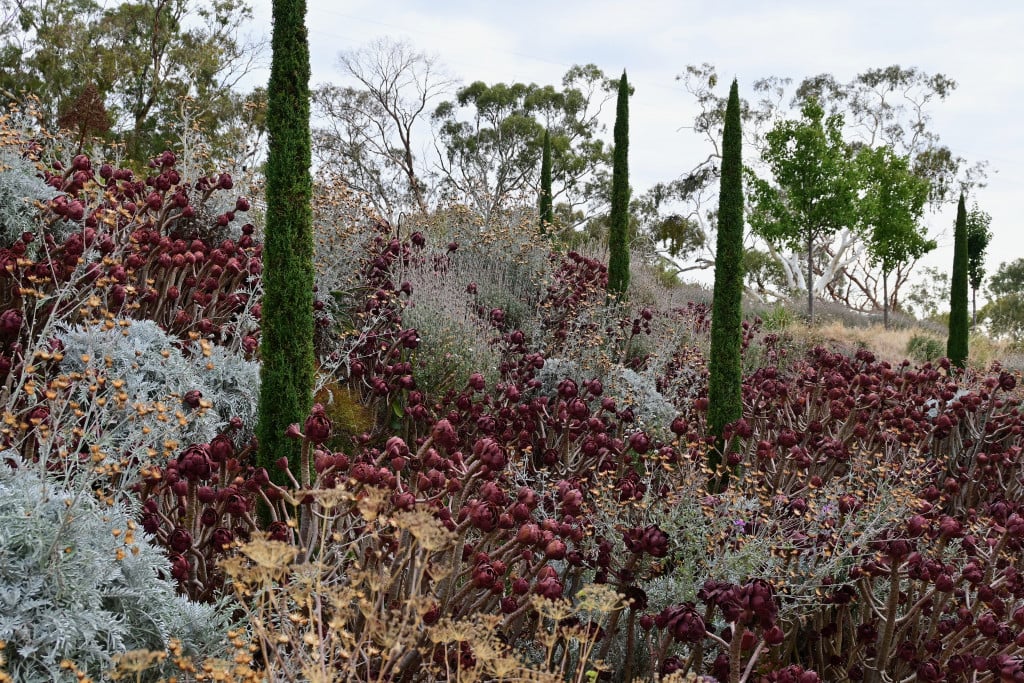If only there were more trees with the emphatic verticality of the Italian cypress.
But there aren’t. The Italian cypress (also known as pencil pine) is a stand alone, in every sense. It stands straight and tall, at rigid attention, hands clamped to its sides. It’s the ultimate one-dimensional character, but, as would be wise for all one-dimensional characters, it plays its one trick, or sings its one song, to the absolute full.
The clarity of the vertical line, with crisp outline, as offered by the best (so far) of all forms of this Italian cypress – Cupressus sempervirens ‘Glauca’ – is as powerful a force, form or shape as one can imagine, holding itself in welcome contrast to the general amorphousness of most other woody plants, and overlaying any amount of horticultural chaos with a sense of order. This is never more evident than in Kurt Wilkinson’s garden, just north of Adelaide. Kurt clips his cypresses into super-slender vertical threads, about (I’m guessing) 150mm across, and about 2m tall, which, along with domes cut from a range of other surprising shrub species, provide a high-point of grooming that sits in extreme and captivating contrast with the rest of the planting, which is never weeded, watered or dead-headed.

But there’s more to the Italian cypress than just its shape and crispness. Vertical lines such as this are very gravity-aware, as they don’t orientate themselves perpendicular to the ground plane, they orientate themselves to the centre of the planet, however the ground lays. This, along with their shape, gives them that pin-like quality, as if they’re pinning the ground in its location. Think of those images of Italian cypresses on steep Tuscan hillsides, where they give the impression of holding the skin of the earth’s surface in place – as if, in their removal, the velvety brown grass layer would slide off down into the valley, like a loose animal pelt.
Unclipped, as in my client’s Traralgon garden (in the lead pic above), Cupressus sempervirens and its various named forms can get up to 30m in height, though it’s rarely more than 8m-10m tall in gardens. Thankfully its very amenable to clipping. Inspired by Nicole De Vesian, I whack the top off mine so they’re just over my head, so when I’m standing in the otherwise low planting of my steppe garden, I’m not the tallest thing there (below). They’re also incredibly tolerant of a wide variety of soils, including very poor soils of sand or clay, as long as they’re not sitting in water.

As for named forms, I would never be tempted to plant anything but Cupressus sempervirens ‘Glauca’. The straight species is often cheaper to buy, but is often seed-raised, resulting in a wide variation in foliage densities and weight of cone production, which tends to pull branches out of the vertical, making for a very shaggy outline. This is less of a problem if you’re prepared to keep them tight by clipping, as does Kurt Wilkinson, and as do the gardeners at Richard Branson’s Lake Como garden (below). The prize for the tightest of all forms actually goes to an Australian variety named ‘Swane’s Gold’. I just wish the ‘gold’ referred to its justified medal for crispness of outline, and not for its gold colouring. I’m yet to be able to conjure a single garden or landscape context which would call for such a thing.
When C. sempervirens ‘Glauca’ hasn’t been available, I’ve occasionally been tempted to use C. sempervirens ‘Nitschke’s Needle’, but it’s never as tight as the former.

Having sung their praises, there’s nothing truly loveable about Italian cypresses. They don’t flower, they have no notable quality of foliage (except, perhaps, for that magic black-green colouring), and there’s a permanent internal dustiness about them. In my imagination, at least, they’re like a car mats that, no matter how long you beat them for, still give off clouds of airborne refuse. But it’s as if, having understood that they’d never be loved, Italian cypresses decided to focus their efforts on being admirable. And what a job they have done.
Hi Michael, love the way you’ve given your cypresses the flat top treatment. In defence of the ‘Swane’s gold’; in my garden it works well contrasted with Cotinus coggyria ‘velvet cloak’ (which is copiced), Sedum ‘autumn joy’, Canna ‘tropicana’and Ceratostigma wilmottiana ‘forestblue’, etc. It’s a fairly vibrant garden to look at from the front verandah which would otherwise be dominated by a mature Cedar. Cheers,
Helen
I’m up for any defence of ‘Swane’s Gold’ – happy to defend the greater truth that there’s no such thing as a bad plant – only a plant badly placed.
And now I imagine that situation, I can see how that gold could work against a green background (not sure if that’s how it works with your cedar, but that’s how I’m imagining it), rather than a great gold tower against the sky, which is how we usually see it. I’d also like to see it trimmed like the normal one is in Kurt Wilkinson’s garden. It could be amazing with it’s size restricted. It’s otherwise such an immense, dominating element
I’ll see how the planting develops. It’s good to know that pruning it is an option. Do you know how the ones in the Lake Como photo are pruned? They look very tall.
They are very tall, and as far as I know, they require ladders leaning against them. Don’t know how that works in these OH@S days. See if you can find a video of Kurt Wilkinson clipping his. His are the tightest I’ve ever known.